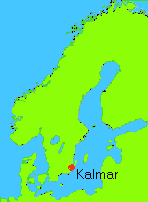Meet the Middle Ages
BackKalmar

Kalmar was one of the most important towns in Sweden. During large parts of the Middle Ages, the province of Blekinge belonged to Denmark, so Kalmar lay near the Danish border.
At the end of the 12th century, King Erik Knutsson built a defence tower in order to control the southern-most part of his kingdom. Towards the end of the 13th century, a magnificent castle was built around the tower. The town of Kalmar grew up next to the tower and the castle. Kalmar was one of the first towns on the Baltic Sea to be built in the German manner. Besides controlling his kingdom, the King also wanted to profit from the trade. An important trading route went through the Kalmar Sound.
Early on, the German merchants were very active in Kalmar. Goods, such as iron, butter, cheese and skins was exported from the harbour in Kalmar and shipped to the German towns. Kalmar imported salt, spices, cloth, wine and beer. There was frequent contact with the continent; travelling monks and knights, books, schools, new kinds of food and so on. In this way, there was an European influence in Kalmar early on. One could say that Kalmar was the gate to Europe.
Since Kalmar was on the border, a town wall was built around the city. In the centre was the square and the Town Hall. Next to it was one of the country ´s largest churches - the Nicolai-church. The Dominican friary lay near the castle. North of the town was a hospice, where the sick and the old were taken care of. In town, there was a smaller church - the church of St. Birgitta, known from the 15th century. The town merchants formed the mighty Guild of St. Christopher. The guild had two houses, where meetings and celebrations were held.
Kalmar had about 2,000 inhabitants around the year 1400 and was one of the largest towns in Sweden. Throughout the Middle Ages, the town was a centre for important political events and meetings. There, in 1397, the so called Kalmar Union was formed by the Nordic countries, and King Eric was crowned in the big church.